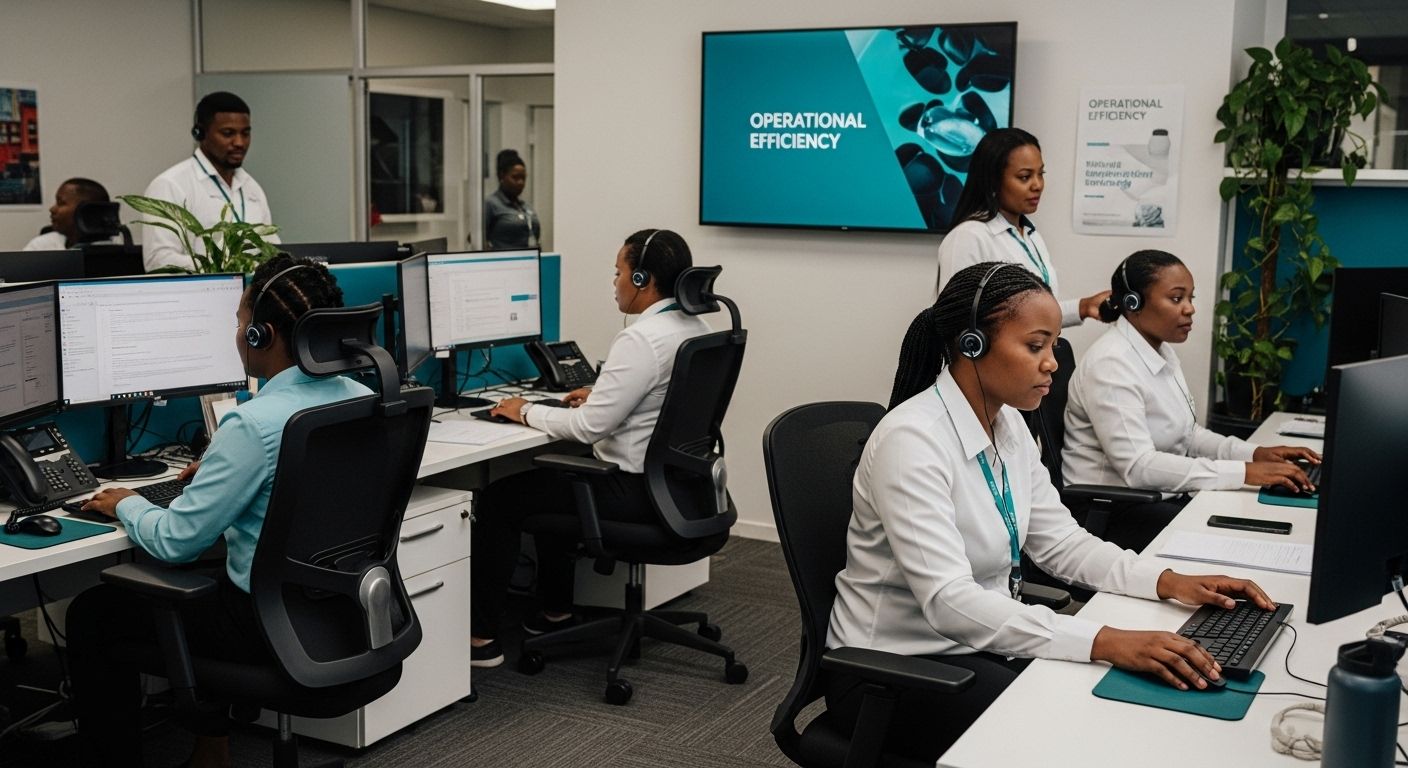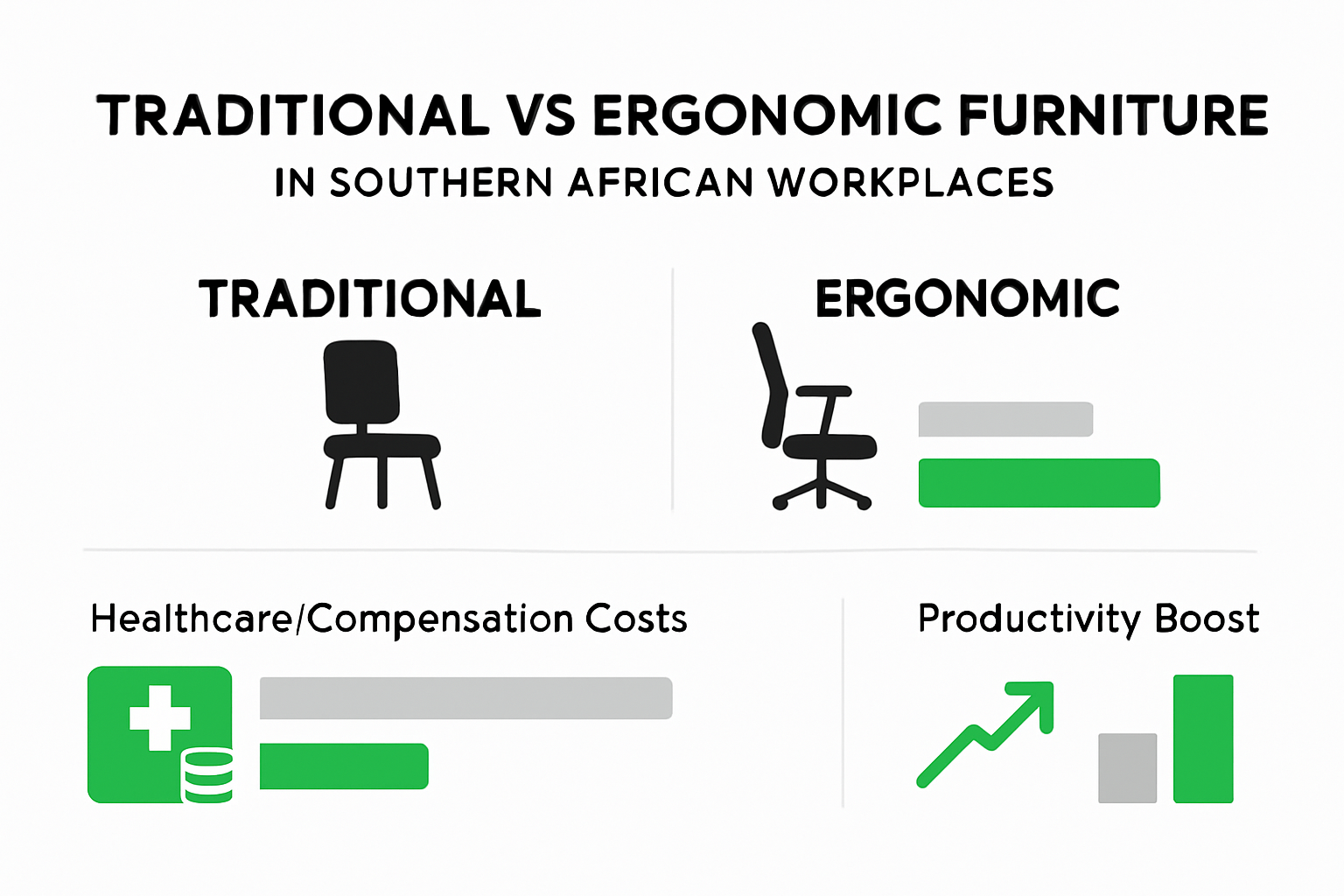Key Benefits of Ergonomic Furniture for Businesses in Southern Africa
Aug 19, 2025
Key Benefits of Ergonomic Furniture for Businesses in Southern Africa

Office chairs and workstations are easily overlooked in most Southern African businesses. Yet a staggering up to 60 percent of workers report discomfort linked to poorly designed office furniture. That sounds like a productivity nightmare brewing under the radar. Most managers think of ergonomic furniture as a luxury but for many companies it turns out to be the smartest investment for cutting costs and building a thriving, healthier team.
Table of Contents
- How Ergonomic Furniture Improves Workplace Health
- Boosting Productivity With Ergonomic Solutions
- Cost Savings And Value For Southern African Businesses
- Adapting Ergonomic Furniture To Diverse Work Environments
Quick Summary
| Takeaway | Explanation |
|---|---|
| Ergonomic furniture reduces health risks. | Properly designed furniture minimizes musculoskeletal disorders and promotes better posture, enhancing physical wellness. |
| Improves mental well-being and productivity. | Comfortable work environments reduce stress, fostering higher levels of concentration and job satisfaction among employees. |
| Leads to long-term cost savings. | Investing in ergonomic solutions decreases healthcare and compensation expenses, benefiting the organization’s bottom line. |
| Enhances operational efficiency. | Ergonomic furniture allows employees to perform better by preventing fatigue, resulting in sustained productivity and focus. |
| Flexible solutions for diverse workplaces. | Customizable ergonomic designs accommodate varying work settings and individual needs, making them effective across different industries. |
How Ergonomic Furniture Improves Workplace Health
Workplace health represents a critical yet often overlooked aspect of organizational performance. Ergonomic furniture plays a transformative role in creating healthier, more productive work environments by addressing fundamental physiological needs and preventing potential long-term health complications.
Mitigating Musculoskeletal Disorders
Prolonged sedentary work poses significant health risks, particularly regarding musculoskeletal disorders. Research from the National Institute for Occupational Safety and Health reveals that ergonomic interventions can substantially reduce workplace-related health issues. Properly designed chairs, adjustable desks, and supportive workstations help employees maintain correct posture, reducing strain on critical body areas like the neck, shoulders, and lower back.
Ergonomic furniture minimizes the risk of developing chronic conditions such as repetitive strain injuries, carpal tunnel syndrome, and chronic back pain. By providing adjustable features that accommodate individual body types and working styles, these furniture solutions enable employees to create personalized, comfortable workspaces that promote physical wellness.
Enhancing Mental Well-being and Productivity
Beyond physical health, ergonomic furniture significantly impacts mental well-being and cognitive performance. When employees are physically comfortable, they experience reduced stress and fatigue. A systematic review published in the medical journal Work demonstrates that ergonomic interventions lead to measurable improvements in workplace comfort and psychological resilience.
Comfortable seating and well-designed workstations decrease physical discomfort, allowing employees to maintain higher levels of concentration and mental engagement. By reducing physical stress, businesses can create environments that support cognitive function, creativity, and overall job satisfaction. This holistic approach to workplace design recognizes that employee health is not merely about preventing injuries but also about fostering an environment conducive to peak performance.
Long-term Health and Cost Benefits
Investing in ergonomic furniture is a strategic decision with significant long-term health and financial implications. The Occupational Safety and Health Administration emphasizes that proactive ergonomic interventions can dramatically reduce workplace injuries and associated compensation costs.
Businesses that prioritize employee health through ergonomic furniture solutions can expect reduced absenteeism, lower healthcare expenses, and improved overall workforce productivity. Moreover, such investments signal to employees that their well-being is a genuine organizational priority, which can enhance workplace morale, retention rates, and talent attraction.
By understanding and implementing ergonomic furniture solutions, businesses in Southern Africa can create healthier, more dynamic work environments that support both individual employee wellness and organizational performance. Learn more about our ergonomic workplace solutions.
To help businesses in Southern Africa quickly grasp the wide-ranging impact of ergonomic furniture, the table below summarises the main health and financial benefits outlined in the article.
| Benefit Area | Impact/Outcome |
|---|---|
| Reduced Musculoskeletal Disorders | Lowers risk of injuries such as repetitive strain, carpal tunnel, and back pain |
| Enhanced Mental Well-being | Decreases stress and fatigue, leading to higher job satisfaction and mental resilience |
| Improved Productivity | Comfortable, supportive furniture reduces fatigue and distractions, enabling better concentration and performance |
| Healthcare & Compensation Cost Savings | Minimises medical expenses, compensation claims, and absence due to workplace-related health issues |
| Lower Absenteeism | Healthier employees are present more often, supporting consistent operations |
| Talent Attraction & Retention | Shows employees their well-being matters, which attracts talent and boosts retention |
| Adaptability to Work Settings | Modular and adjustable furniture can be tailored to individual and sector-specific needs |
Boosting Productivity with Ergonomic Solutions
Productivity is the cornerstone of organizational success, and ergonomic furniture emerges as a strategic tool for enhancing workplace performance. By creating environments that support physical comfort and cognitive efficiency, businesses can unlock significant productivity gains through thoughtful workplace design.
Reducing Physical Fatigue and Performance Barriers
A systematic review from 2024 revealed that proper ergonomic assessment and furniture design directly correlate with reduced musculoskeletal disorders and improved workplace comfort. When employees are not battling physical discomfort, they can channel more energy and mental focus into their core work responsibilities.
Height-adjustable workstations and chairs that support natural body mechanics enable workers to maintain optimal posture throughout the day. Research on height-adjustable workstations demonstrates that reducing prolonged sitting can significantly mitigate physical strain, allowing employees to maintain higher levels of concentration and engagement.
Cognitive Performance and Work Efficiency
Ergonomic solutions do more than prevent physical discomfort they actively enhance cognitive performance. Furniture that supports natural body movements reduces mental fatigue, enabling employees to maintain sharper focus and more sustained productivity. Adjustable workstations that allow employees to alternate between sitting and standing positions promote better blood circulation, which can directly impact mental alertness and problem-solving capabilities.
By minimizing physical distractions and creating comfortable work environments, businesses can create conditions that naturally encourage higher levels of creativity, critical thinking, and task completion efficiency. The psychological benefit of feeling physically supported cannot be understated in its impact on overall work performance.
Economic Benefits of Ergonomic Investments
An integrative review from 2022 highlighted the economic advantages of workplace ergonomic interventions. Beyond immediate productivity gains, ergonomic furniture represents a strategic investment with measurable returns. Reduced absenteeism, lower healthcare costs, and increased employee retention are tangible benefits that extend far beyond initial furniture expenditures.
Businesses that prioritize ergonomic solutions signal a commitment to employee well-being, which can significantly boost morale, attract top talent, and create a positive organizational culture. The correlation between employee comfort and organizational performance is increasingly clear: when employees feel supported, they perform at their best.
For Southern African businesses seeking to optimize workplace performance, explore our comprehensive ergonomic workplace solutions that transform how teams work and achieve their potential.
Cost Savings and Value for Southern African Businesses
Ergonomic furniture represents more than a workplace aesthetic choice it is a strategic financial investment with substantial long-term economic benefits for Southern African businesses. Understanding the comprehensive financial advantages of ergonomic solutions can help organizations make informed decisions that protect both employee well-being and bottom-line performance.
Reducing Healthcare and Compensation Expenses
Research published in the International Journal of Environmental Research and Public Health demonstrates that proactive ergonomic interventions significantly reduce musculoskeletal disorders among workers. By minimizing workplace-related health issues, businesses can dramatically decrease healthcare costs and potential compensation claims.
The financial implications are substantial. Workplace injuries and chronic health conditions resulting from poor ergonomics can lead to expensive medical treatments, extended sick leave, and potential legal liabilities. Ergonomic furniture acts as a preventative measure, creating work environments that inherently reduce the risk of such costly health complications.
Productivity and Operational Efficiency
According to the Occupational Safety and Health Administration, implementing ergonomic solutions directly correlates with improved workplace efficiency. When employees experience less physical strain and discomfort, they can maintain higher levels of productivity and focus, translating into tangible economic benefits for the organization.
Indirect cost savings emerge through reduced absenteeism, lower employee turnover, and enhanced overall workplace performance. Companies investing in ergonomic furniture signal a commitment to employee well-being, which can improve talent attraction and retention rates. This strategic approach transforms furniture from a mere expense to a valuable organizational asset.

Long-term Financial Strategy
For Southern African businesses operating in competitive markets, ergonomic furniture represents a forward-thinking financial strategy. The initial investment in high-quality, adaptable furniture generates returns through improved employee health, reduced workplace injury risks, and enhanced operational productivity.
Small and medium enterprises can particularly benefit from this approach. By making strategic investments in ergonomic solutions, businesses can create workplace environments that support employee performance while managing long-term operational costs. The cumulative financial advantages extend beyond immediate productivity gains, offering a comprehensive approach to workplace management.

Businesses seeking to optimize their workplace investments should consider ergonomic furniture not as an expense, but as a critical component of their strategic financial planning. Learn more about our cost-effective ergonomic solutions designed specifically for Southern African businesses.
Adapting Ergonomic Furniture to Diverse Work Environments
Modern Southern African workplaces demand flexible, adaptable solutions that cater to increasingly diverse work environments. Ergonomic furniture represents more than a standardized approach it is a nuanced strategy for addressing unique workplace requirements across different industries, office layouts, and individual worker needs.
Customization for Different Work Settings
Research published in PubMed highlights the critical importance of adjustable office furniture in reducing musculoskeletal symptoms. Different work environments from open-plan offices to home workstations require furniture that can be easily modified to suit varying body types, work styles, and physical requirements.
Adjustable chairs with multiple configuration options, height-adaptable desks, and modular workstations enable businesses to create flexible spaces that accommodate diverse employee needs. This approach recognizes that a one-size-fits-all solution is ineffective in modern dynamic work environments. Height-adjustable chairs, lumbar support mechanisms, and adaptive armrests allow individual workers to create personalized ergonomic configurations that support their unique physical characteristics.
Technological Integration and Workplace Flexibility
A comprehensive study from the National Center for Biotechnology Information demonstrates that ergonomic interventions significantly reduce pain intensity across multiple body regions. In the context of Southern African businesses, this means creating workspaces that can seamlessly transition between collaborative and individual work modes.
Modern ergonomic furniture incorporates technological considerations, featuring integrated power outlets, cable management systems, and compatibility with digital devices. These features support the growing trend of hybrid work environments, allowing employees to efficiently switch between different work settings without compromising comfort or productivity. Furniture that supports mobile technology, provides easy connectivity, and allows quick workspace reconfiguration becomes crucial in adapting to evolving work paradigms.
Industry-Specific Ergonomic Solutions
A systematic review and meta-analysis underscores the importance of tailored ergonomic interventions across different work environments. Southern African businesses span various sectors, from tech startups to traditional manufacturing, each requiring specialized ergonomic approaches.
Industry-specific ergonomic furniture solutions consider unique workplace demands. For instance, call centers might require different chair designs compared to design studios or engineering workshops. Furniture manufacturers now develop specialized ranges that address sector-specific ergonomic challenges, incorporating materials, support structures, and design elements that cater to particular work requirements.
The following table compares how ergonomic furniture can be customised to different work settings and industries, based on requirements and key features mentioned in the article.
| Work Environment | Key Ergonomic Requirements | Example Features/Adjustments |
|---|---|---|
| Open-plan Offices | Flexibility for multiple users | Modular workstations, adjustable chairs, shared height-adjustable desks |
| Home Workstations | Adaptation to limited space | Compact adjustable desks, ergonomic task chairs, portable support aids |
| Call Centres | Prolonged sitting, phone use | Specialised chairs with enhanced lumbar support, adjustable armrests |
| Design Studios/Creative Work | Movement, various tasks | Swivel chairs, moveable desks, flexible seating arrangements |
| Engineering Workshops | Standing & sitting tasks, durability | Height-adjustable benches, robust chairs, anti-fatigue mats |
Businesses seeking comprehensive ergonomic solutions that adapt to their unique workplace needs can explore our customizable workplace furniture options. Our expert team understands that ergonomic excellence is about creating flexible, responsive environments that support worker health and organizational performance.
Frequently Asked Questions
What are the main benefits of ergonomic furniture for businesses?
Ergonomic furniture reduces health risks, enhances mental well-being and productivity, leads to long-term cost savings, improves operational efficiency, and provides flexible solutions for diverse workplaces.
How does ergonomic furniture reduce musculoskeletal disorders?
Ergonomic furniture is designed to promote proper posture and reduce strain on the body. Features like adjustable chairs and desks allow employees to customize their workspace, preventing injuries such as chronic back pain and repetitive strain injuries.
Can ergonomic furniture improve employee productivity?
Yes, ergonomic furniture enhances productivity by reducing physical discomfort and mental fatigue. Comfortable work environments enable employees to maintain higher levels of concentration, creativity, and efficiency throughout the workday.
How can businesses adapt ergonomic furniture for different work environments?
Businesses can customize ergonomic furniture to suit specific needs, such as open-plan offices or home workstations, by using adjustable desks and chairs, modular seating arrangements, and ensuring features that cater to various tasks and physical requirements.
Transform Your Office into a Healthier, More Productive Space
Are aches and fatigue silently draining your team’s energy and performance? If you have noticed that discomfort, absenteeism or low morale are slowing down your workplace, the issues discussed in this article are all too familiar. Poorly designed furniture can lead to musculoskeletal disorders, higher healthcare costs and frustrated staff. The good news is that these pain points are avoidable. Office Stock delivers solutions proven to improve posture, comfort and productivity in businesses across Southern Africa.

Make a smart investment in your business and your people. Upgrade your workspace with premium ergonomic furniture that helps you attract talent, cut down on long-term expenses and create an inspiring office environment. Visit Office Stock to discover durable ergonomic chairs, adaptable desks and storage products tailored for South African workplaces. If you want personalised advice or want to start planning your next office upgrade, contact our team of experts today through our homepage. Experience a real difference in health, happiness and business outcomes—act now and take the first step towards a transformed office.
